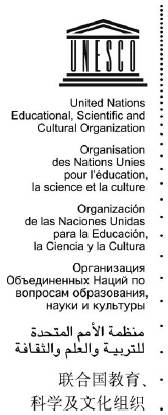 |
Message from Ms Irina Bokova,Director-General of UNESCOon the occasion of the Press Conference of the International Year of CrystallographyLondon, 12 December 2013The year 2014 has been proclaimed the International Year of Crystallography. Exactly a century ago, it was discovered that X-rays could be used to 'see' the structure of matter in a non-intrusive manner. Today, X-ray crystallography has become the leading technique for studying the structure of matter at the atomic or molecular level. The International Year commemorates the centennial of the discovery of X-ray crystallography, thanks to the work of William Henry Bragg, William Lawrence Bragg and Max von Laue. Crystallography has shaped the history of the 20th century. It has made a vital contribution to our understanding of the very basis of life itself, notably through the work of Francis Crick and James Watson who, with a valuable contribution from the crystallographer Rosalind Franklin, revealed some 60 years ago that the structure of DNA was a double helix. In the past 50 years, the structures of more than 90,000 biological molecules have been revealed by crystallographers, with great ramifications for health care. Today, crystallography underpins all the sciences. It forms the backbone of a wide range of industries, including pharmaceuticals, agri-foodstuffs, aeronautics, computing, mining and space sciences. It is essential for the development of almost all new materials. In this light, it is clear that crystallography will be indispensable for nurturing the scientific innovation which all countries need for their sustainable development and to build greener societies and economies. Yet many countries still lack expertise in this field. This is why UNESCO and the International Union of Crystallography are joining forces to shine the spotlight on crystallography in 2014. The fact is that, even though it permeates our lives, crystallography remains largely unknown. How many people realize when they board a plane or take medication that these products are the fruit of a long process that began with crystallography? Every country must invest in this field and our message is that they can – crystallography is accessible to all and can be performed in a university setting, with relatively inexpensive equipment, without sophisticated infrastructure. All countries can enjoy considerable social and economic benefits from modest investments – and the International Year of Crystallography will demonstrate how. The Year will be launched at UNESCO in Paris on 20−21 January, with representatives of governments, academia and the private sector attending from across the world. There will be a special focus on the role crystallography plays in development. Throughout the year, UNESCO and the International Union of Crystallography will be providing interested governments with guidance on curricular and research development. We shall be organizing a number of open labs in developing countries, in order to show how crystallography works, in partnership with private companies. The first labs will be equipped and ready by early 2014 in Argentina, Côte d’Ivoire, Morocco, South Africa and Uruguay. In conclusion, I wish to invite all governments to join us in raising the flag for crystallography throughout 2014 and beyond. Irina Bokova |
![[Irina Bokova]](https://www.iycr2014.org/__data/assets/image/0004/85171/ib.jpg) |
Irina Bokova has been Director-General of the United Nations Educational, Scientific and Cultural Organization (UNESCO) since 2009. She is the first woman to head UNESCO. Ms Bokova is a former Minister for Foreign Affairs of Bulgaria and Coordinator of Bulgaria-European Union relations (1995-1997). She has always promoted European integration, including as Minister for Foreign Affairs and as Chair and founding member of the European Policy Forum. |


